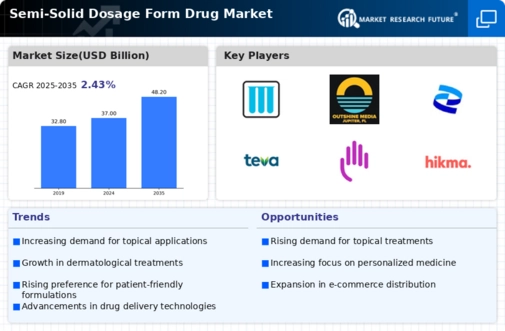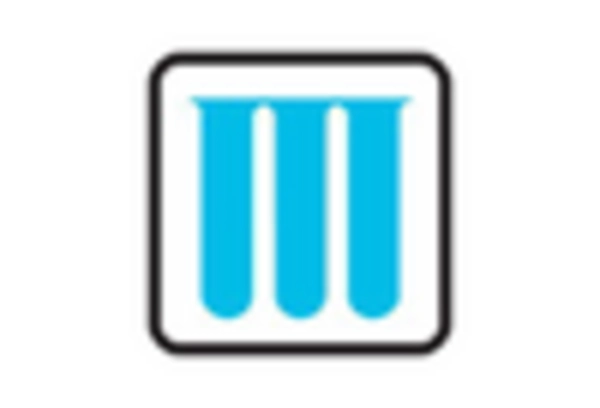Increasing Prevalence of Skin Disorders
The rising incidence of skin disorders, such as eczema, psoriasis, and dermatitis, is a notable driver for the Semi-Solid Dosage Form Drug Market. As these conditions become more prevalent, the demand for effective topical treatments is likely to surge. According to recent data, skin disorders affect millions of individuals worldwide, leading to a heightened need for innovative semi-solid formulations. These formulations, which include creams, ointments, and gels, offer targeted delivery and enhanced patient compliance. The Semi-Solid Dosage Form Drug Market is thus positioned to benefit from this trend, as pharmaceutical companies focus on developing specialized products to address these dermatological issues. Furthermore, the increasing awareness of skin health and the importance of early treatment may further propel market growth.
Rising Demand for Personalized Medicine
The increasing demand for personalized medicine is emerging as a significant driver for the Semi-Solid Dosage Form Drug Market. As healthcare shifts towards tailored treatment approaches, semi-solid formulations are being developed to meet the unique needs of individual patients. This trend is particularly evident in dermatology, where personalized topical treatments are gaining traction. Market Research Future suggests that the ability to customize formulations based on patient-specific factors, such as skin type and condition severity, could enhance treatment efficacy. Consequently, pharmaceutical companies are investing in the development of semi-solid dosage forms that can be easily modified to suit individual requirements. This focus on personalization is likely to propel the Semi-Solid Dosage Form Drug Market forward, as it aligns with broader trends in healthcare that prioritize patient-centered care.
Regulatory Support for Innovative Formulations
Regulatory bodies are increasingly supporting the development of innovative semi-solid formulations, which is positively impacting the Semi-Solid Dosage Form Drug Market. Initiatives aimed at expediting the approval process for new drug applications are encouraging pharmaceutical companies to invest in research and development. This regulatory environment fosters innovation, allowing for the introduction of novel semi-solid products that meet specific therapeutic needs. Furthermore, the emphasis on patient safety and efficacy in formulation development aligns with the goals of regulatory agencies, potentially leading to a more robust market landscape. As companies navigate these supportive regulatory frameworks, the Semi-Solid Dosage Form Drug Market is likely to witness a surge in new product launches, enhancing competition and diversity within the market.
Growing Preference for Non-Invasive Administration
The growing preference for non-invasive drug administration methods is a key driver for the Semi-Solid Dosage Form Drug Market. Patients increasingly favor topical treatments over oral or injectable options due to their ease of use and reduced risk of side effects. Semi-solid formulations, such as creams and gels, provide a convenient alternative for delivering medications directly to the affected area, thereby improving patient adherence. Market data indicates that the semi-solid segment is expanding as healthcare providers recognize the benefits of these formulations in managing various conditions. This trend is likely to continue, as the Semi-Solid Dosage Form Drug Market adapts to meet the evolving preferences of patients and healthcare professionals alike, potentially leading to increased market penetration.
Technological Innovations in Drug Delivery Systems
Technological advancements in drug delivery systems are significantly influencing the Semi-Solid Dosage Form Drug Market. Innovations such as nanotechnology and microencapsulation are enhancing the efficacy and stability of semi-solid formulations. These technologies allow for improved absorption and controlled release of active ingredients, which can lead to better therapeutic outcomes. The market is witnessing a shift towards more sophisticated formulations that cater to specific patient needs. For instance, the incorporation of bioactive compounds into semi-solid forms is becoming increasingly common, potentially expanding the therapeutic applications of these products. As a result, the Semi-Solid Dosage Form Drug Market is likely to experience growth driven by these technological advancements, which may also attract investment from pharmaceutical companies seeking to enhance their product portfolios.

















Leave a Comment